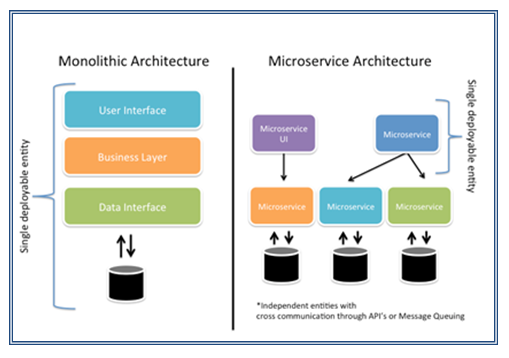2016 heralds in Microservices, the emerging new trend in the world of Cloud Servicing. The idea is to have small highly scalable and highly available applications that run on cloud environments. Simply put, Microservices can be defined as “Loosely coupled service oriented architecture with bounded contexts”.
What it means is that, Microservices are small independent units of code, which are developed to function without any dependencies on the underlying architecture. They contain everything from the operating system, platform, framework, runtime and dependencies, packaged as one unit of execution.
They are independently deployable, small, modular services in which each service runs a unique process and communicates through APIs. They can be invoked as HTTP/REST endpoints or via a well-defined, lightweight messaging mechanism such as RabbitMQ. As they are loosely coupled with each other thus avoiding synchronous and blocking-calls whenever possible.
Why Microservices came into existence
Microservice is not much different from the SOA concept. Microservice is not a replacement for SOA, but an additional technology service. It essentially does the same thing, but with a new set of tools and best practices.
Built on a Monolithic platform, if any new features or changes were made to the services, the new changes had to be batched together, tested and deployed as part of a new release. This risked the service having defects and time to market issues.
The key difference is that Microservices runs in its own process and communicates via lightweight mechanisms, often an HTTP resource API. In the service model, many services may be hosted within that single process. If any one of those services needs additional capacity, the entire process must be scaled. In a Microservice architecture, you can add capacity for only the service that needs it.
This makes applications more flexible and also changes the software development process. With organizations frequently rolling out updates, often multiple times a day, patching the larger systems with software updates is not a feasible option. Instead you can deliver a new version of the Microservices to replace the previous version of what is required.
Challenges faced by Microservices
One problem that is associated with the Microservices container is the identity and access management. You have the problem of authentication, which involves embedding the host name of the identity of the Microservices container.
Microservices can use cloud API management systems to perform some of the event driven functions. Depending on whether the event is triggered or not, the required resources are allocated and released. They can also be used to make it easy to build dynamic facades on top for the APIs, to make the Microservices usable by other groups. In essence, the API management tools can help bridge the gap between Microservices and more enterprise-grade SOA architectures.
Microservices also face the problem of network bottlenecks resulted through frequent accessing of data. It overcomes this through caching of the frequently used data.
Benefit of Microservices
High Scalability -Microservices and the Cloud are inter related. You can use a cloud platform and cloud technologies to enable the Microservices. The dynamic nature of cloud platform enables Microservices to scale up or down according to the business needs and network traffic. A properly configured cloud deployment, will automatically scale up or down to keep the load balance.
Flexible and Resilient – Even if one Microservices fails, it doesn’t impact the functioning of the other services. Here typically many instances of a Microservices are deployed into the system for load balancing and resilience purposes. As they are loosely coupled, they tend to degrade gracefully as the system comes under more load.
Quick time to Deploy – It uses an agile development model, which means you can deploy a new feature or functionality and iterate on the system faster. Because of its decoupled nature, you can modify just one system component, test it, and then push it to production outside of any centrally mandated release cycle.
Simple, easy development – As the Microservice application is responsible only for one thing, it requires less code and is easy to understand. It also has less risk of affecting the other services.
You contact us at info@sysfore.com or call us at +91-80-4110-5555 to benefit from implementing Microservices in your Cloud Computing.


